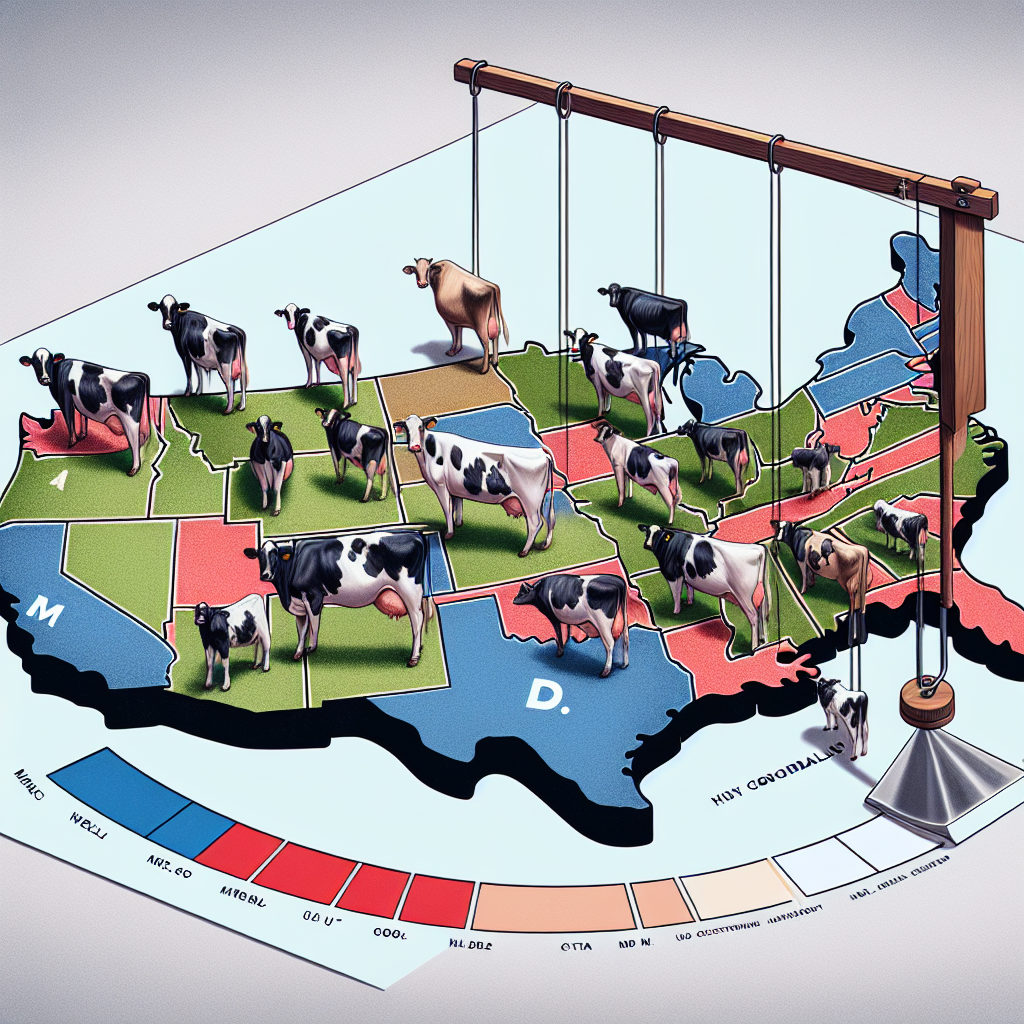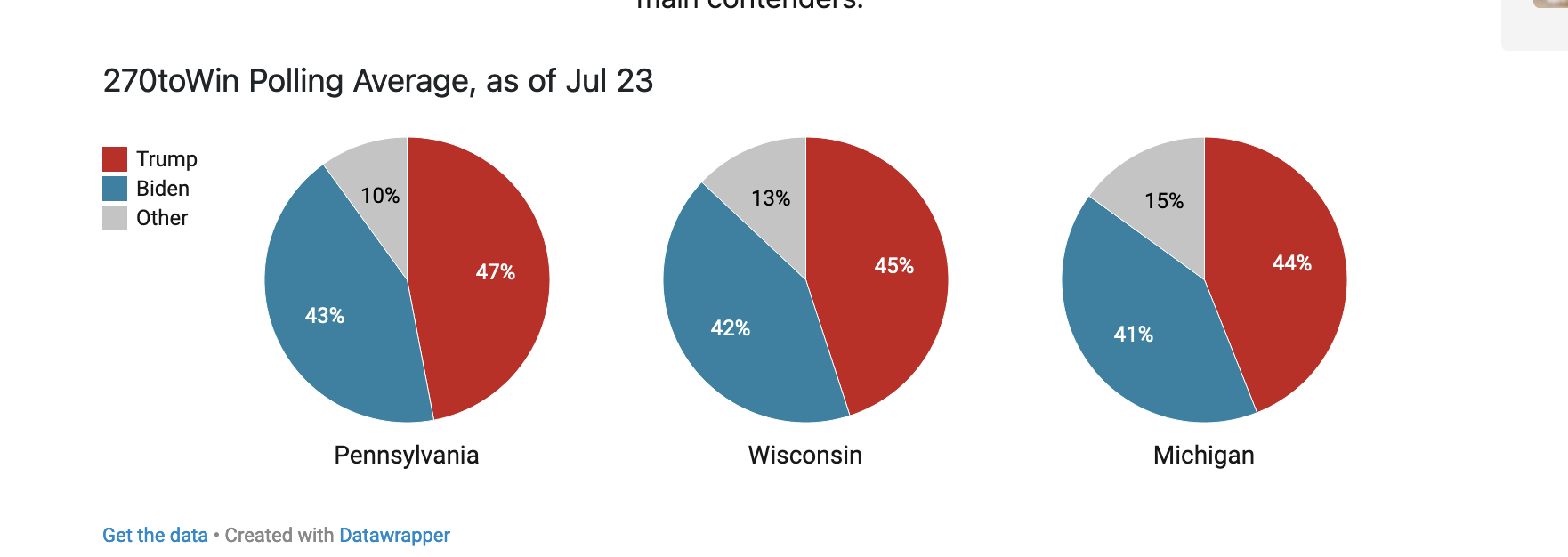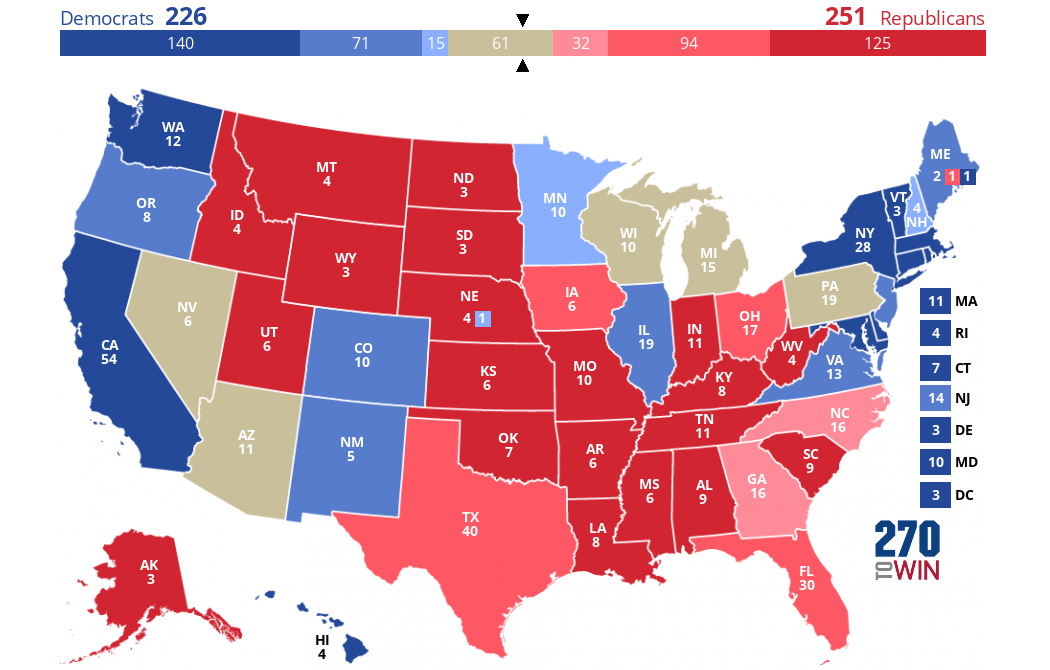Could dairy-producing swing states like Pennsylvania, Wisconsin, and Michigan decide the 2024 election? Discover how these key states hold the keys to the White House.

If you are a dairy farmer in America’s heartland, the 2024 presidential election will significantly impact your livelihood. With Joe Biden’s withdrawal, the field has narrowed to Donald Trump and Kamala Harris. This conflict is about more than simply politics; it is about policies influencing agricultural subsidies, trade, and rural development, all of which are essential to the dairy business. Farmers are America’s backbone, and policy choices determine their success or failure. Despite Biden’s departure, crucial states like Pennsylvania, Wisconsin, and Michigan remain essential. These top dairy-producing areas are critical for achieving an Electoral College win and implementing policies that affect dairy operations, such as milk price and labor restrictions. Dairy producers should be aware and active since the decision will impact their future.
Swing States: The Heartbeat of the U.S. Presidential Election
Swing states, or battlegrounds where neither major political party has overwhelming power, are essential to the U.S. presidential election. Because the Electoral College is winner-take-all, these states are critical in determining the result. While certain states continuously vote Democratic or Republican, swing states change parties from election to election, making them essential campaign objectives.
Swing states are important because they may tilt the balance of power. As contenders compete for the 270 electoral votes required to win the President, the unpredictable nature of swing states encourages them to devote disproportionate time, money, and resources to gaining an advantage. This electoral calculation implies that wins in these critical places may balance losses in more predictable locations.
Historically, states like Pennsylvania, Wisconsin, and Michigan have represented the swing state phenomena. Their shifting political allegiances highlight their status as kingmakers in presidential elections. For example, the razor-thin wins and subsequent reversals seen in these states during the 2016 and 2020 elections demonstrate how swing states may shift the whole electoral map.
As a result, the significance of swing states goes beyond simple numbers; they reflect the fluid and changing sands of public opinion that politicians must negotiate. The emphasis on these states highlights the more extensive approach of adapting communications and policies to local issues, highlighting their importance in selecting who occupies the White House.
From Coast to Heartland: The Powerhouses of America’s Dairy Industry
The United States has a diverse and vibrant dairy sector, with numerous states leading the way in milk production. California is the most significant supplier, accounting for most of the nation’s milk supply. California’s agricultural geography supports dairy farms and allied businesses, and the state produces a substantial amount of milk yearly.
Wisconsin, sometimes known as “America’s Dairyland,” is critical to the United States dairy industry. Wisconsin produces a large volume of milk, contributing considerably to the country’s cheese and other dairy products.
While Idaho is not historically known as a dairy powerhouse, the state’s dairy business has expanded rapidly. The state’s good dairy farming circumstances have allowed it to become a significant participant, contributing significantly to the national milk supply.
Texas, renowned for its extensive ranches and agricultural operations, contributes considerably to U.S. milk production. Texas’ dairy business is diversified, with a mix of large-scale commercial farms and traditional family-owned companies serving local and national markets.
New York remains a central dairy-producing state in the heavily populated Northeast. New York’s dairy farms contribute significantly to the national milk supply, highlighting the state’s long-standing legacy.
Michigan leads in dairy production with efficient agricultural procedures and high-yield cows. Michigan’s dairy farms provide:
- A tremendous output.
- Ranking #1 nationwide in pounds of milk produced per dairy cow.
- Making the state an essential player in the national dairy scene.
Breach and Reclaim: The Battleground States of 2016 and 2020
Pennsylvania, Wisconsin, and Michigan were in the limelight during the 2016 and 2020 elections because of their significant roles in deciding presidential outcomes. Historically, these states have formed part of the so-called “Blue Wall,” a phrase used to designate states that have consistently voted Democratic in presidential elections. However, the strength of this wall was severely tested and finally broken in 2016, when Donald Trump won all three states by razor-thin margins.
Trump won Pennsylvania by around 44,000 votes, overturning a state that reliably voted for Democratic candidates since 1992. Wisconsin had an even thinner margin, with Trump winning by little over 22,000 votes, the first time the state voted Republican since 1984. Michigan followed a similar trend, with Trump winning by around 10,700 votes, the narrowest margin in the nation that year and a significant shift from its past Democratic leanings.
Let’s fast forward to the 2020 election. These states resurfaced as important battlegrounds, but this time, Biden was successful in recovering them for the Democrats, although by similar thin margins. Biden won Pennsylvania by roughly 80,000 votes, Wisconsin by nearly 20,000, and Michigan by about 154,000. This razor-thin victory highlighted the states’ continued competitiveness and importance on the political map.
The varying voting patterns in Pennsylvania, Wisconsin, and Michigan throughout these two election cycles demonstrate their volatility and relevance. Their position as members of the Blue Wall is no longer taken for granted, making them significant targets in future Democratic and Republican elections.
As November 5 Approaches, Dairy States Pennsylvania, Wisconsin, and Michigan Become Electoral Epicenters
As the November 5 election date approaches, the emphasis shifts to the critical dairy-producing battleground states of Pennsylvania, Wisconsin, and Michigan. According to the most recent surveys and estimates compiled by 270toWin, the race remains very close, with both Trump and Harris vying for supremacy in these critical areas.

Pennsylvania: Trump now leads by a razor-thin 1% edge, indicating a very close contest that might go either way if voter opinion evolves. The state’s substantial dairy business should not be underestimated since it influences rural and urban voters.
Wisconsin: Polls show a similarly acrimonious climate, with Trump leading Harris by 0.5%. This state’s dairy industry, the second-largest in the country, remains a critical political battlefield, with both candidates intensively campaigning to persuade hesitant voters.
Michigan: Unlike Pennsylvania and Wisconsin, Harris leads Trump by 1.2%. Known for its high milk output per cow, Michigan remains a trailblazer despite shifting political preferences and economic ties to the dairy sector.
These forecasts highlight the precarious balance among these states, which jointly hold the keys to the White House. As both major parties ramp up their efforts, the impact of the dairy sector on rural economic policy and environmental concerns cannot be understated. Trump and Harris both appreciate the importance of these sectors, and their campaigns include focused attempts to win over this critical voting category.
Electoral College Dynamics: The Keystone of the Presidential Race
The Electoral College is at the heart of the United States presidential election system, allocating votes to states based on congressional representation. Each state’s total electoral votes are equal to the number of senators (always two) plus the number of representatives (which varies according to population). A contender must get a majority of these electoral votes, at least 270 out of 538, to win the presidency.
The current consensus projection highlights the precarious balance of power. According to 270toWin, Republicans have 251 electoral votes while Democrats have 226. This leaves a limited margin for both parties to move, with Pennsylvania, Wisconsin, and Michigan emerging as critical players in the electoral equation. These states, an essential section of the so-called Blue Wall, have traditionally shifted between the two parties and are expected to be hotly fought again in 2024.

Pennsylvania, with its 20 electoral votes, is particularly significant. If Republicans win this state, they will have enough votes to surpass the 270-vote barrier and capture the President. In contrast, if Democrats duplicate their achievement in 2020 by capturing Pennsylvania, Wisconsin (10 votes), and Michigan (16 votes), they will jump ahead, gaining precisely 270 votes. This scenario would leave Republicans fighting for the remaining 17 electoral votes in less predictable states like Nevada and Arizona.
The electoral map, therefore, depicts a closely fought campaign in which the fortunes of Pennsylvania, Wisconsin, and Michigan will most likely decide the nation’s political destiny. As the campaigns heat up, both parties will surely devote significant resources and strategic attention to these battleground states, knowing their unmatched relevance in determining the result of the 2024 election.
Economic Influence: How Dairy Drives Both Industry and Politics in Crucial Battleground States
The economic impact of the dairy sector in Pennsylvania, Wisconsin, and Michigan must be considered. These states are major election battlegrounds and dairy powerhouses, with the industry serving as a critical foundation of their local economy. Dairy farms provide billions of dollars in income, support thousands of employment, and contribute to rural towns’ socioeconomic fabric. Dairy farming has a far-reaching impact on related businesses such as feed production, veterinary services, and dairy processing. This economic importance translates into significant political weight; aspirants for the White House cannot afford to ignore it.
Dairy policy is more than a specialized interest for these states’ electorates; it directly influences their lives. As candidates consider maximizing subsidies for small-to-medium-sized dairy producers, balancing land use rules, and tackling significant environmental problems such as methane emissions and water pollution, vote shifts in favor of solid dairy assistance might be crucial. Regulatory policies that offer more support for sustainable farming practices while reducing regulatory burdens on family-scale enterprises may win favor with voters here. As a result, the emphasis on dairy policy may lead to significant differences in voter preferences, underscoring the sector’s position as a predictor of overall election results.
Strategic Gambits: The Electoral Chessboard of Pennsylvania, Wisconsin, and Michigan
The electoral fates of Pennsylvania, Wisconsin, and Michigan provide fascinating possibilities for drastically changing the election picture. If the Republicans win all three states, the electoral map will alter substantially. Under this scenario, Trump would secure the requisite electoral votes with a clear advantage, putting all Democratic dreams to rest, even probable victories in other battlegrounds such as Nevada and Arizona. This Republican sweep would demonstrate their ability to overturn previously blue districts.
In contrast, a Democratic sweep of seven key states leads them to 270 electoral votes, securing Kamala Harris’ triumph. This result would be similar to Biden’s victory in 2020, confirming the party’s capacity to reclaim and keep control of the Blue Wall. This scenario would demonstrate the Democrats’ political strategy’s efficacy and connection with voter concerns in these key dairy states.
A split scenario, in which each party claims one or two of these states, might result in a fractious and uncertain election night. For example, suppose Trump wins Pennsylvania, and Harris wins Michigan and Wisconsin. In that case, both candidates’ paths to victory will be shorter, depending primarily on the remaining swing states to tilt the balance. This fractured result would highlight each electoral vote’s razor-thin margins and essential significance.
The Bottom Line
As the political landscape shifts, the impact of key dairy-producing states such as Pennsylvania, Wisconsin, and Michigan in the race for the White House is apparent. These states might choose the next President of the United States. These dairy states are agricultural powerhouses and critical political battlegrounds, alternating between Republican and Democratic leadership. The recent polls show a fierce contest that can change the Electoral College balance.
Beyond political significance, the decisions here will influence the lives of dairy farmers who face issues such as shifting milk prices and environmental laws. Dairy producers and stakeholders must participate actively in the election process. Advocacy, developing connections with political candidates, and casting educated votes are more important than ever. Your impact goes beyond the farm and into America’s political process. Make your opinion known and help influence the future of both the country and dairy sectors’ future.
Key Takeaways:
- Joe Biden’s withdrawal hasn’t drastically altered the election landscape, with Trump and Kamala Harris emerging as principal contenders.
- Dairy states like Pennsylvania, Wisconsin, and Michigan remain pivotal in determining the electoral outcome, similar to their significance in the 2016 and 2020 elections.
- These states are categorized under the “Blue Wall,” historically Democratic but hotly contested in recent elections.
- Current electoral projections indicate a tight race, with the Republican and Democratic parties needing these key states to secure victory.
- The influence of the dairy industry in these states underscores the importance of political and economic strategies tailored to this sector.
- Public relations and advocacy efforts by the dairy industry could potentially sway voter sentiment and impact the election results.
- The economic and regulatory environment shaped by the election outcomes will significantly affect the dairy industry’s future.
Summary:
The 2024 presidential election will significantly impact dairy farmers in the US, with swing states like California, Wisconsin, Idaho, Texas, New York, and Michigan playing crucial roles in the dairy sector. Pennsylvania, Wisconsin, and Michigan were historically part of the “Blue Wall” and voted Democratic in presidential elections. However, Donald Trump won all three states by razor-thin margins in 2016, and Biden successfully recovered them for Democrats in the 2020 election. The Electoral College, which allocates votes to states based on congressional representation, is at the heart of the U.S. presidential election system. Dairy policy directly influences the lives of these states’ electorates, making the 2024 election a pivotal moment for the dairy industry.












